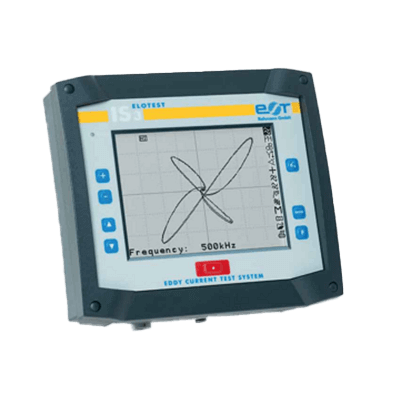What Is an Eddy Current Flaw Detector?

Eddy Current Flaw Detectors are devices that use eddy currents to measure flaws in objects.
It can nondestructively inspect metal products for defects such as cracks, breaks, and scratches. There are various types of flaw detectors, including magnetic particle detectors, penetrant detectors, and ultrasonic flaw detectors, in addition to Eddy Current Flaw Detectors.
Among these, Eddy Current Flaw Detectors are easy to operate and feature non-contact measurement. They are also used for inspecting aircraft and automobiles, as well as for testing conductivity and the thickness of thin films. This is because not only flaws but also conductivity and film thickness are related to changes in eddy currents.
Uses of Eddy Current Flaw Detectors
Eddy Current Flaw Detectors are mainly used to inspect scratches and defects on the surface of metal products. In addition to defect inspection, they can also be applied to paint and plating film thickness. Eddy Current Flaw Detectors are used for the following five purposes
1. inspection of surface flaws and internal defects near the surface of metal products
Used to check for surface cracks in forgings, which is a processing method for metal products, and for cracks caused by heat treatment; to check for cracks, chips, and other defects in sintered parts; to inspect wire rod, pipe, and round bar for surface defects; and to inspect the surface of bearing balls and rolls. 2.
2. sorting of different materials in metal products
Used to identify changes in alloy mixing ratios and to determine whether or not a material has been quenched. 3.
3. Quality assurance of metal products
Inspection of wall thinning of pipe products, cracks under painted surfaces, and cracks in welds of bridges and steel frame construction are some of the applications of eddy current flaw detector.
4. checking for changes in paint and plating thickness
Uniformity of paint and plating thickness is required. The eddy current flaw detector can detect changes in thickness.
5. metal contamination of resin, etc.
Metal contamination of resin products can be inspected with an eddy current flaw detector.
Principle of Eddy Current Flaw Detector
Eddy Current Flaw Detector first generates magnetic flux by passing an electric current through a coil. When the coil, which has generated a magnetic flux, is brought close to the object to be inspected, an eddy current is generated on the surface to be measured. This is due to magnetic induction.
The eddy currents generated on the inspected object vary depending on the presence or absence of scratches or defects. This is because surface defects cause distortion in the eddy currents, which should be uniform. Therefore, Eddy Current Flaw Detectors determine the presence or absence and size of flaws by the changes in the eddy currents generated in the inspected object.
Measurement methods such as Eddy Current Flaw Detectors enable non-contact, nondestructive inspection of objects. This inspection method is suitable for continuous product inspection work and is widely used in the aircraft and automobile industries. It is also used to check for scratches and surface conditions on metal products.
However, because it uses electromagnetic induction, it is not possible to inspect outside the effective range of the magnetic field generated. Although non-contact inspection is possible, the inspection range is limited to the vicinity of the product surface only.
Eddy Current Flaw Detector Features
Eddy Current Flaw Detectors have six major features.
1. Non-ferrous metals can be inspected
Eddy Current Flaw Detectors can inspect any conductive material. Not only magnetic materials such as ferrous materials, but also nonferrous, non-magnetic materials can be inspected.
2. surface and near-surface inspection
Eddy Current Flaw Detectors can inspect not only the surface but also near-surface defects. Magnetic materials can be inspected down to about 0.1 mm from the surface, and non-magnetic materials can be inspected down to about 2 mm from the surface.
3. Suitable for inspection of products such as bars, wires, and pipes
For long products, inspection can be performed in a short period of time. It is also suitable for on-line inspection by incorporating it into the production line.
4. non-contact inspection
Eddy Current Flaw Detector is not only a non-destructive inspection, but also a non-contact inspection that does not touch the product. The inspection is performed while maintaining a clearance of 1 mm or less with the object to be inspected.
5. suitable for inspecting products at high temperatures, fine wires, and bore bores
Eddy Current Flaw Detectors use magnetic induction for inspection, so the temperature of the product does not matter. It is also possible to inspect products with high temperature, such as bar materials immediately after being drawn. Eddy Current Flaw Detectors are also suitable for inspecting fine wires and bore diameters, depending on the shape of the detection coil.
6. suitable for automated inspection
Eddy Current Flaw Detectors output inspection results as electrical signals. By setting up a program to detect changes in the electrical signal, the inspection process can be easily automated.